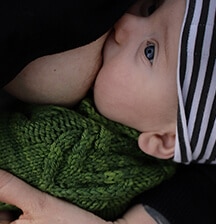
When it comes to who’s looking after your baby, there are a number of childcare options – so which one will work best for your family? Here are four to consider.
In an ideal world, all mums would be able to choose to stay home full-time with their babies from birth for as long as they want to. But modern life isn’t ideal, and for a growing number of mums, returning to work while their babies are still young is a necessity. Whether you work full-time or part-time, from your home or from an office, there’s bound to be a childcare option which suits you – you just need time to investigate and make a decision you’re comfortable and confident with.
Nanny or nanny share
A nanny is a childcarer who comes into your home and cares for your child or children one-on-one. Nannies are usually trained in childcare and first aid and are more likely to be available for the hours you need them to be. Nannies can also do related housework such as light cleaning, cooking for the children, and the children’s laundry. The more experienced and quali ed the nanny, the higher the hourly rate. Or you can share a nanny with another family or families (depending on how many children you have – keep in mind that babies need more hands-on care than older children). Nanny-sharing will bring down the cost, but there are other considerations – you’ll likely need to rotate whose home the children spend the day at and you’ll need to work out what happens if your child is ill, who provides food and snacks, how to split payment if one family is on holiday and the other is not, etc.
Tip
If your nanny is taking your baby on outings using her own car, provide her with appropriate child restraints for her vehicle, and ensure you’re paying her mileage on top of her hourly rate.
Real mums tell:
“I work part-time and have a nanny for my four-month-old son three days a week, where he gets one-on-one time and is cared for in my home. The nanny does all the things I would normally do with my son – takes him on outings, puts him down for a nap, feeds him, and plays with him. I like that he is in his home environment and can keep to his schedule. It is more expensive than other options but at this early stage of his life I am more comfortable knowing he is looked after by one single person and in my home.” ~ Jessica
Au Pair
An au pair usually comes from a foreign country and lives in your home, providing childcare in return for accommodation, meals, and a weekly fee. Usually they are trained in childcare (although this can be quite minimal training, unlike nannies, so check with your agency) and first aid. Their hours can be quite exible, as they are living with your family and tting in with your family routine, so an au pair may be a good option for parents who work unusual hours or weekends. Usually au pairs are young women (not always, though!) who come to New Zealand for six months to a year, perhaps longer, with the intention of seeing the country and improving their English. Some au pairs work part-time while studying. While the cost of an au pair is comparable to daycare or in-home childcare, keep in mind you’ll also need to account for the costs of accommodation, meals, and a vehicle if you are asking the au pair to drive your child anywhere. Many families particularly enjoy the cultural learnings of having someone from a different country live with them and expose their children to a new language and customs.
Tip
Usually your au pair will be contracted to do a certain number of hours of childcare per week. If you want them to babysit so you can have a night out, be sure you’re paying for this or it’s negotiated as part of their regular hours.
Real Mums Tell:
“For our first baby, we had a wonderful au pair from Germany who lived with us for six months and provided 30 hours of childcare each week. She was such a great helper to me as I was transitioning back to work when my daughter was ve months old. We still keep in touch now! For our second baby, I needed to return to work when my son was only three months old, as I was heading up a big project. Again we had an au pair who cared for both children. She was young and energetic, and the care she provided for my kids during the day meant I didn’t have to worry and I could enjoy coming home in the evenings to enjoy my time with them guilt-free.” ~ Becky
98% is the government’s target for children participating in early childhood education (ECE) in 2016
Daycare
Some other names for “daycare” are early childhood centres, childcare centres, or preschools, and they provide care for children from birth to age five. Daycare ratios differ between centres depending on policies and the amount of quali ed teachers they employ, but if they are looking after infants, they should have a lower teacher-to-baby ratio because babies require more hands-on care. Daycares can be open from early in the day (7.30am or sometimes earlier) to after business hours (5.30 to 6.30pm, and sometimes later) to accommodate the commutes of working parents. They can sometimes have part-time options, but are generally more popular for parents who work full-time. Because daycare centres usually have a number of teachers to look after the children, you won’t have to come up with a back-up plan if your childcarer is sick – that’s their responsibility. Staff are trained in rst aid and qualified daycare teachers have training in education, not just childcare, so your child will have the benfit of caregivers with a background in early childhood education and theory.
Tip
Check out a few different daycare centres to nd one which matches your family’s philosophy and needs, and ask friends for their experiences.
Real Mums Tell:
“My daughter started at daycare when she was six months old. At first I was reluctant because the centre seemed to be so big, but I soon realised that it was the perfect place for her. The staff were engaged and did professional development so they were always upskilling, and there were a number of checks and balances in place to ensure my baby was always well looked after, fed, and changed. I could look in her record book at the end of each day and see when and how long she slept, what she ate, whether she was fussy, etc. Each baby was assigned a teacher who was their main caregiver and every day the teacher made a point to talk to me about how my daughter’s day went. I could call or visit any time and was always welcomed.” ~ Meena
In-home childcare
An in-home childcarer looks after children in their home (and sometimes in one of the families’ homes), sometimes caring for one or more of their own children at the same time they care for yours and/or another family’s children. Usually the child-to- adult ratio is one adult to no more than four children, including no more than two children under the age of two. They are usually trained in childcare and hold rst-aid certi cates as a requirement of working with their agency – you can ask to see this paperwork and they should have it on hand. Their homes are inspected regularly by their agency to ensure safety and childproofing. An in-home carer can be a cost-effective option for parents with infants who aren’t able to afford a one-on-one nanny but prefer a smaller home-based environment. They can usually provide exible hours which can be helpful for parents who start work early or nish late.
Tip
Talk to potential in-home caregivers about their policies around sick days. Some will require you to pay if your child is sick and doesn’t attend on that day, but won’t charge if they are sick and can’t look after your child.
Real Mums Tell
“My son was cared for by an in-home childcarer from the age of four months, as I’m a single mum and went back to work after 14 weeks of maternity leave. I loved that he was in a home environment. There were three other children there – three-year- old twin girls from another family, and the caregiver’s own son, who was also three. The older children were lovely with the baby and I really appreciated that the caregiver treated my son like he was her own. They went on “everyday” outings like to the supermarket together, and to play groups and music groups. The agency we found her through had regular weekly events for other caregivers in the local area so they had a lot to do and were very supported.” ~ Rachael








